Legal Contract and Negligence Law: Analysis of Case Scenarios
VerifiedAdded on 2023/05/29
|7
|2627
|140
AI Summary
This article provides an analysis of legal contract and negligence law in two case scenarios involving a supermarket, a phone sale, a flower company, and a driver. It covers the relevant laws, application of law, and conclusions.
Contribute Materials
Your contribution can guide someone’s learning journey. Share your
documents today.

1
Contents
Solution......................................................................................................................................2
Solution (a).................................................................................................................................2
i)..............................................................................................................................................2
Issue....................................................................................................................................2
Relevant law.......................................................................................................................2
Application of law..............................................................................................................2
Conclusion..........................................................................................................................3
ii).............................................................................................................................................3
Issue....................................................................................................................................3
Relevant Law......................................................................................................................3
Application of Law.............................................................................................................3
Conclusion..........................................................................................................................3
Solution (b).................................................................................................................................3
Issue....................................................................................................................................3
Relevant Law......................................................................................................................4
Application of Law.............................................................................................................4
Conclusion..........................................................................................................................6
Bibliography...............................................................................................................................7
Contents
Solution......................................................................................................................................2
Solution (a).................................................................................................................................2
i)..............................................................................................................................................2
Issue....................................................................................................................................2
Relevant law.......................................................................................................................2
Application of law..............................................................................................................2
Conclusion..........................................................................................................................3
ii).............................................................................................................................................3
Issue....................................................................................................................................3
Relevant Law......................................................................................................................3
Application of Law.............................................................................................................3
Conclusion..........................................................................................................................3
Solution (b).................................................................................................................................3
Issue....................................................................................................................................3
Relevant Law......................................................................................................................4
Application of Law.............................................................................................................4
Conclusion..........................................................................................................................6
Bibliography...............................................................................................................................7
Secure Best Marks with AI Grader
Need help grading? Try our AI Grader for instant feedback on your assignments.

2
Solution
Solution (a)
i)
Issue
Whether there is a legal contract amid Amy and the supermarket?
Relevant law
A legal contract is the combination of several elements which consists of an agreement (an
offer plus and acceptance), legal consideration, party’s capacity and the intention of the
parties. (Fisher & Greenwood, 2011)
An offer is the prime essential which starts the formation of the contract. The offeror when
transfers his intention either orally or by words or conduct to the offeree with the belief of
approval, then, such an act is an offer. An offer can be to specific person or to the world and
is held in (Carlill v Carbolic Smoke Ball Company , 1892). The confirmation of the offer by
the offeree is an acceptance in law (Felthouse v Bindley, 1862). (Fisher & Greenwood, 2011)
At times, the party does not wish to make an offer but desirers to receive offers. Such acts are
called invitation to treat. The inviter with the help of advertisements, tenders, auctions, etc,
may invites people from the public to make an offer to him (Partridge v Crittenden [, 1968).
The inviter then acts like an offeree and if gave his approval to such offer results in the
formation of a contract with such offeror. In, (Pharmaceutical Society of Great Britain v
Boots Cash Chemists , 1953), the display of goods in the shop is considered to be an
invitation to treat and any person who wishes to buy the displayed products must pick them
up and bring them to the counter. This act is an offer from the intended buyer. If the cashier
accepts the offer of the buyer then there is a contract otherwise there is no binding contract
amid the two. (Mau, 2010)
Application of law
Amy visits the great supermarket to buy the groceries. The groceries are placed at the shelf.
She picks the same and fills her basket. Now, as per (Pharmaceutical Society of Great Britain
v Boots Cash Chemists , 1953), the display of goods is an act of invitation and thus the
display of groceries by the supermarket is just an invitation that is made. So, Amy must make
an offer to the supermarket to buy the same and if the supermarket accepts the offer then
there is a contract amid the two.
But, Amy when approached the cashier she receives a call from her secretary and she has to
reach to her boss immediately. She puts down the products and wanted to leave. It is
submitted that Amy only has picked up the groceries but she has not made any offer to the
cashier to buy the products.
Solution
Solution (a)
i)
Issue
Whether there is a legal contract amid Amy and the supermarket?
Relevant law
A legal contract is the combination of several elements which consists of an agreement (an
offer plus and acceptance), legal consideration, party’s capacity and the intention of the
parties. (Fisher & Greenwood, 2011)
An offer is the prime essential which starts the formation of the contract. The offeror when
transfers his intention either orally or by words or conduct to the offeree with the belief of
approval, then, such an act is an offer. An offer can be to specific person or to the world and
is held in (Carlill v Carbolic Smoke Ball Company , 1892). The confirmation of the offer by
the offeree is an acceptance in law (Felthouse v Bindley, 1862). (Fisher & Greenwood, 2011)
At times, the party does not wish to make an offer but desirers to receive offers. Such acts are
called invitation to treat. The inviter with the help of advertisements, tenders, auctions, etc,
may invites people from the public to make an offer to him (Partridge v Crittenden [, 1968).
The inviter then acts like an offeree and if gave his approval to such offer results in the
formation of a contract with such offeror. In, (Pharmaceutical Society of Great Britain v
Boots Cash Chemists , 1953), the display of goods in the shop is considered to be an
invitation to treat and any person who wishes to buy the displayed products must pick them
up and bring them to the counter. This act is an offer from the intended buyer. If the cashier
accepts the offer of the buyer then there is a contract otherwise there is no binding contract
amid the two. (Mau, 2010)
Application of law
Amy visits the great supermarket to buy the groceries. The groceries are placed at the shelf.
She picks the same and fills her basket. Now, as per (Pharmaceutical Society of Great Britain
v Boots Cash Chemists , 1953), the display of goods is an act of invitation and thus the
display of groceries by the supermarket is just an invitation that is made. So, Amy must make
an offer to the supermarket to buy the same and if the supermarket accepts the offer then
there is a contract amid the two.
But, Amy when approached the cashier she receives a call from her secretary and she has to
reach to her boss immediately. She puts down the products and wanted to leave. It is
submitted that Amy only has picked up the groceries but she has not made any offer to the
cashier to buy the products.
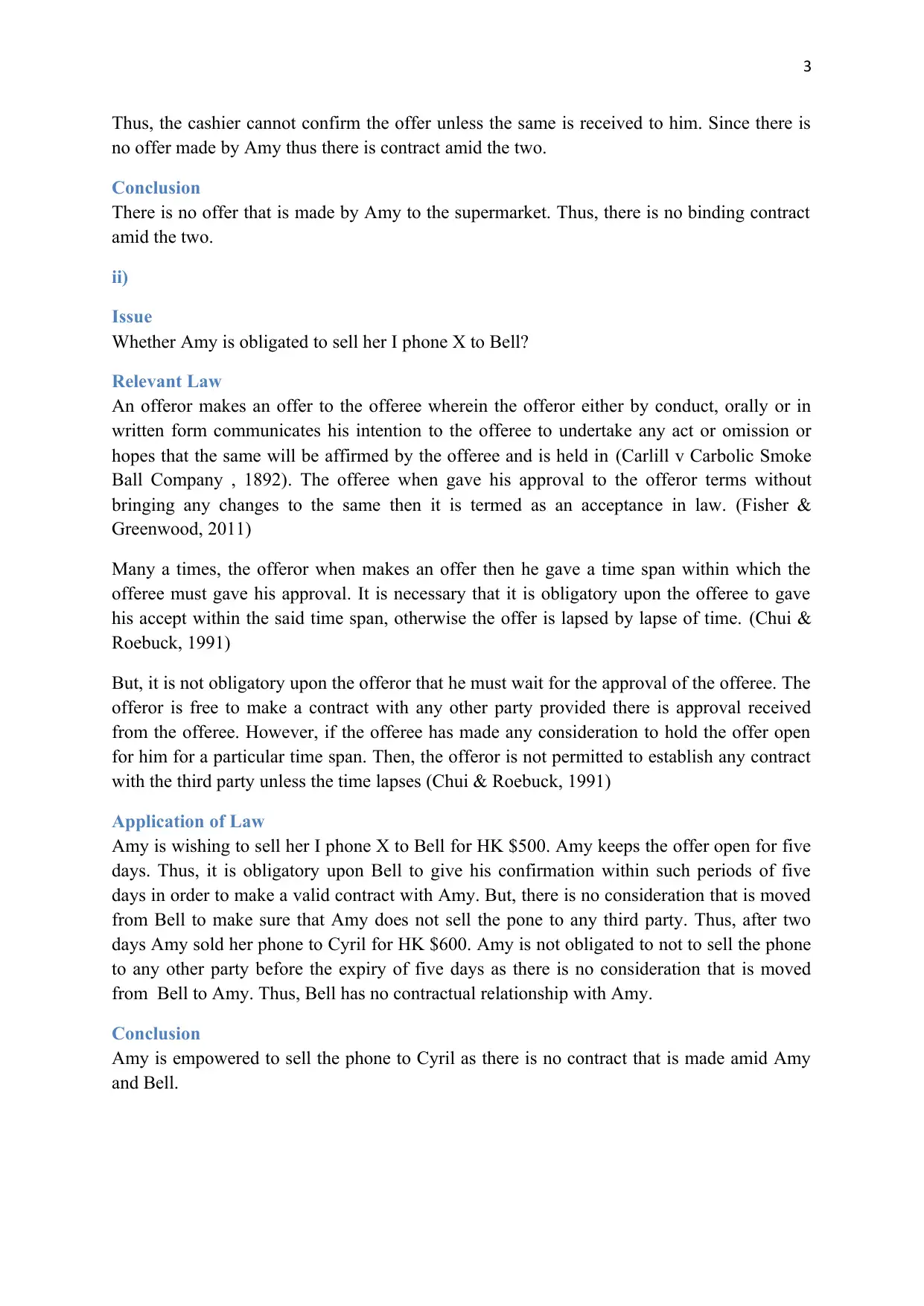
3
Thus, the cashier cannot confirm the offer unless the same is received to him. Since there is
no offer made by Amy thus there is contract amid the two.
Conclusion
There is no offer that is made by Amy to the supermarket. Thus, there is no binding contract
amid the two.
ii)
Issue
Whether Amy is obligated to sell her I phone X to Bell?
Relevant Law
An offeror makes an offer to the offeree wherein the offeror either by conduct, orally or in
written form communicates his intention to the offeree to undertake any act or omission or
hopes that the same will be affirmed by the offeree and is held in (Carlill v Carbolic Smoke
Ball Company , 1892). The offeree when gave his approval to the offeror terms without
bringing any changes to the same then it is termed as an acceptance in law. (Fisher &
Greenwood, 2011)
Many a times, the offeror when makes an offer then he gave a time span within which the
offeree must gave his approval. It is necessary that it is obligatory upon the offeree to gave
his accept within the said time span, otherwise the offer is lapsed by lapse of time. (Chui &
Roebuck, 1991)
But, it is not obligatory upon the offeror that he must wait for the approval of the offeree. The
offeror is free to make a contract with any other party provided there is approval received
from the offeree. However, if the offeree has made any consideration to hold the offer open
for him for a particular time span. Then, the offeror is not permitted to establish any contract
with the third party unless the time lapses (Chui & Roebuck, 1991)
Application of Law
Amy is wishing to sell her I phone X to Bell for HK $500. Amy keeps the offer open for five
days. Thus, it is obligatory upon Bell to give his confirmation within such periods of five
days in order to make a valid contract with Amy. But, there is no consideration that is moved
from Bell to make sure that Amy does not sell the pone to any third party. Thus, after two
days Amy sold her phone to Cyril for HK $600. Amy is not obligated to not to sell the phone
to any other party before the expiry of five days as there is no consideration that is moved
from Bell to Amy. Thus, Bell has no contractual relationship with Amy.
Conclusion
Amy is empowered to sell the phone to Cyril as there is no contract that is made amid Amy
and Bell.
Thus, the cashier cannot confirm the offer unless the same is received to him. Since there is
no offer made by Amy thus there is contract amid the two.
Conclusion
There is no offer that is made by Amy to the supermarket. Thus, there is no binding contract
amid the two.
ii)
Issue
Whether Amy is obligated to sell her I phone X to Bell?
Relevant Law
An offeror makes an offer to the offeree wherein the offeror either by conduct, orally or in
written form communicates his intention to the offeree to undertake any act or omission or
hopes that the same will be affirmed by the offeree and is held in (Carlill v Carbolic Smoke
Ball Company , 1892). The offeree when gave his approval to the offeror terms without
bringing any changes to the same then it is termed as an acceptance in law. (Fisher &
Greenwood, 2011)
Many a times, the offeror when makes an offer then he gave a time span within which the
offeree must gave his approval. It is necessary that it is obligatory upon the offeree to gave
his accept within the said time span, otherwise the offer is lapsed by lapse of time. (Chui &
Roebuck, 1991)
But, it is not obligatory upon the offeror that he must wait for the approval of the offeree. The
offeror is free to make a contract with any other party provided there is approval received
from the offeree. However, if the offeree has made any consideration to hold the offer open
for him for a particular time span. Then, the offeror is not permitted to establish any contract
with the third party unless the time lapses (Chui & Roebuck, 1991)
Application of Law
Amy is wishing to sell her I phone X to Bell for HK $500. Amy keeps the offer open for five
days. Thus, it is obligatory upon Bell to give his confirmation within such periods of five
days in order to make a valid contract with Amy. But, there is no consideration that is moved
from Bell to make sure that Amy does not sell the pone to any third party. Thus, after two
days Amy sold her phone to Cyril for HK $600. Amy is not obligated to not to sell the phone
to any other party before the expiry of five days as there is no consideration that is moved
from Bell to Amy. Thus, Bell has no contractual relationship with Amy.
Conclusion
Amy is empowered to sell the phone to Cyril as there is no contract that is made amid Amy
and Bell.
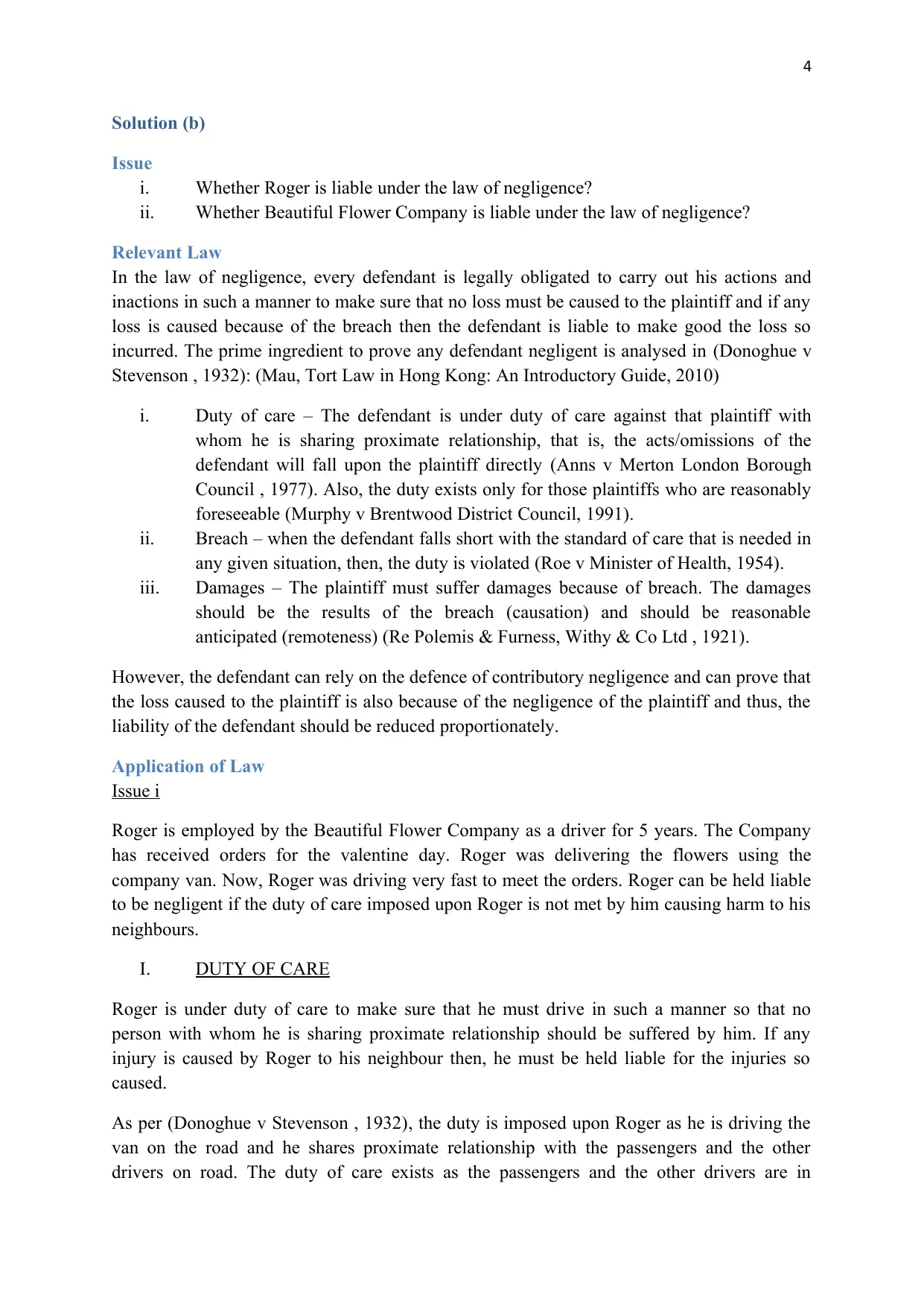
4
Solution (b)
Issue
i. Whether Roger is liable under the law of negligence?
ii. Whether Beautiful Flower Company is liable under the law of negligence?
Relevant Law
In the law of negligence, every defendant is legally obligated to carry out his actions and
inactions in such a manner to make sure that no loss must be caused to the plaintiff and if any
loss is caused because of the breach then the defendant is liable to make good the loss so
incurred. The prime ingredient to prove any defendant negligent is analysed in (Donoghue v
Stevenson , 1932): (Mau, Tort Law in Hong Kong: An Introductory Guide, 2010)
i. Duty of care – The defendant is under duty of care against that plaintiff with
whom he is sharing proximate relationship, that is, the acts/omissions of the
defendant will fall upon the plaintiff directly (Anns v Merton London Borough
Council , 1977). Also, the duty exists only for those plaintiffs who are reasonably
foreseeable (Murphy v Brentwood District Council, 1991).
ii. Breach – when the defendant falls short with the standard of care that is needed in
any given situation, then, the duty is violated (Roe v Minister of Health, 1954).
iii. Damages – The plaintiff must suffer damages because of breach. The damages
should be the results of the breach (causation) and should be reasonable
anticipated (remoteness) (Re Polemis & Furness, Withy & Co Ltd , 1921).
However, the defendant can rely on the defence of contributory negligence and can prove that
the loss caused to the plaintiff is also because of the negligence of the plaintiff and thus, the
liability of the defendant should be reduced proportionately.
Application of Law
Issue i
Roger is employed by the Beautiful Flower Company as a driver for 5 years. The Company
has received orders for the valentine day. Roger was delivering the flowers using the
company van. Now, Roger was driving very fast to meet the orders. Roger can be held liable
to be negligent if the duty of care imposed upon Roger is not met by him causing harm to his
neighbours.
I. DUTY OF CARE
Roger is under duty of care to make sure that he must drive in such a manner so that no
person with whom he is sharing proximate relationship should be suffered by him. If any
injury is caused by Roger to his neighbour then, he must be held liable for the injuries so
caused.
As per (Donoghue v Stevenson , 1932), the duty is imposed upon Roger as he is driving the
van on the road and he shares proximate relationship with the passengers and the other
drivers on road. The duty of care exists as the passengers and the other drivers are in
Solution (b)
Issue
i. Whether Roger is liable under the law of negligence?
ii. Whether Beautiful Flower Company is liable under the law of negligence?
Relevant Law
In the law of negligence, every defendant is legally obligated to carry out his actions and
inactions in such a manner to make sure that no loss must be caused to the plaintiff and if any
loss is caused because of the breach then the defendant is liable to make good the loss so
incurred. The prime ingredient to prove any defendant negligent is analysed in (Donoghue v
Stevenson , 1932): (Mau, Tort Law in Hong Kong: An Introductory Guide, 2010)
i. Duty of care – The defendant is under duty of care against that plaintiff with
whom he is sharing proximate relationship, that is, the acts/omissions of the
defendant will fall upon the plaintiff directly (Anns v Merton London Borough
Council , 1977). Also, the duty exists only for those plaintiffs who are reasonably
foreseeable (Murphy v Brentwood District Council, 1991).
ii. Breach – when the defendant falls short with the standard of care that is needed in
any given situation, then, the duty is violated (Roe v Minister of Health, 1954).
iii. Damages – The plaintiff must suffer damages because of breach. The damages
should be the results of the breach (causation) and should be reasonable
anticipated (remoteness) (Re Polemis & Furness, Withy & Co Ltd , 1921).
However, the defendant can rely on the defence of contributory negligence and can prove that
the loss caused to the plaintiff is also because of the negligence of the plaintiff and thus, the
liability of the defendant should be reduced proportionately.
Application of Law
Issue i
Roger is employed by the Beautiful Flower Company as a driver for 5 years. The Company
has received orders for the valentine day. Roger was delivering the flowers using the
company van. Now, Roger was driving very fast to meet the orders. Roger can be held liable
to be negligent if the duty of care imposed upon Roger is not met by him causing harm to his
neighbours.
I. DUTY OF CARE
Roger is under duty of care to make sure that he must drive in such a manner so that no
person with whom he is sharing proximate relationship should be suffered by him. If any
injury is caused by Roger to his neighbour then, he must be held liable for the injuries so
caused.
As per (Donoghue v Stevenson , 1932), the duty is imposed upon Roger as he is driving the
van on the road and he shares proximate relationship with the passengers and the other
drivers on road. The duty of care exists as the passengers and the other drivers are in
Secure Best Marks with AI Grader
Need help grading? Try our AI Grader for instant feedback on your assignments.
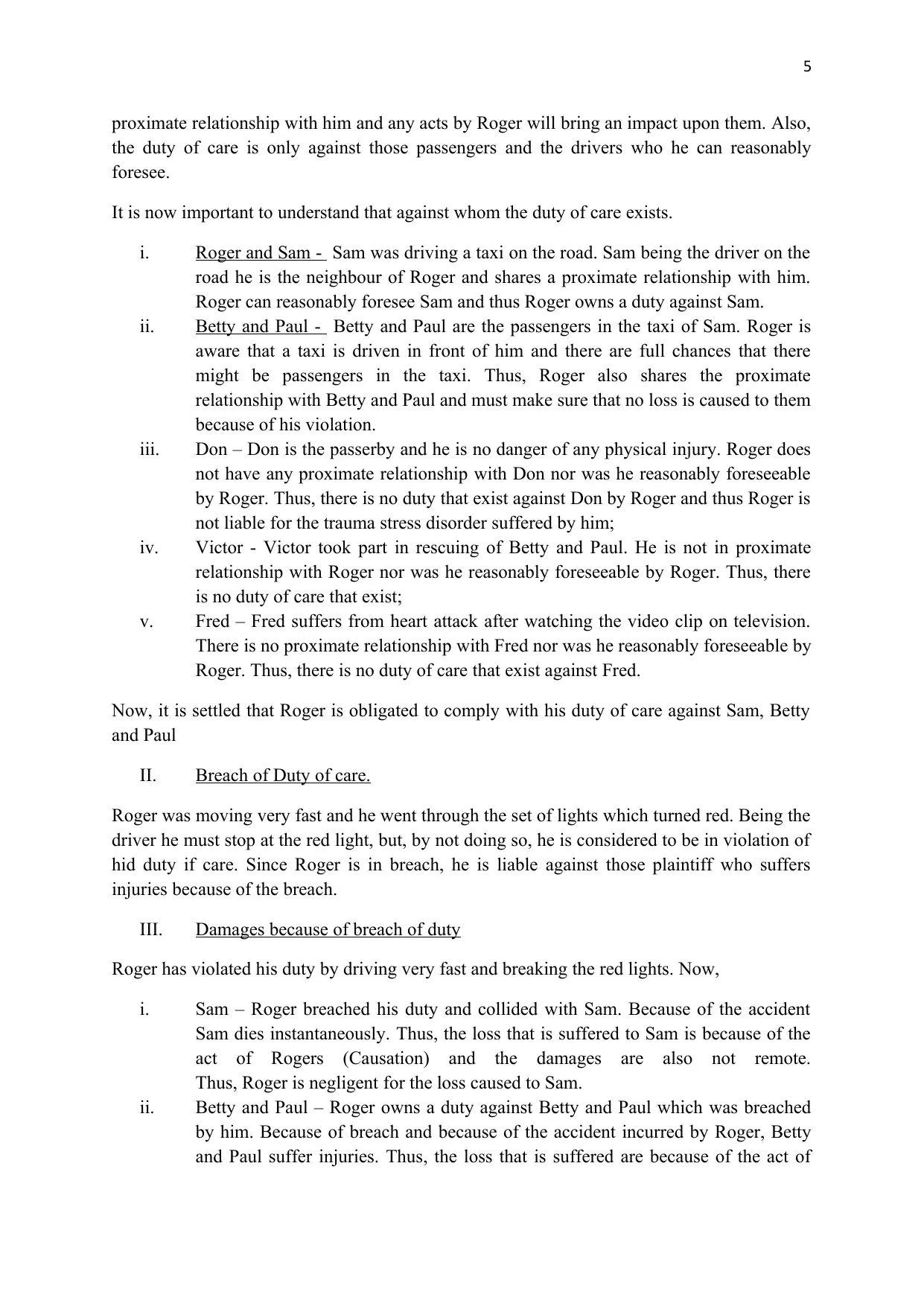
5
proximate relationship with him and any acts by Roger will bring an impact upon them. Also,
the duty of care is only against those passengers and the drivers who he can reasonably
foresee.
It is now important to understand that against whom the duty of care exists.
i. Roger and Sam - Sam was driving a taxi on the road. Sam being the driver on the
road he is the neighbour of Roger and shares a proximate relationship with him.
Roger can reasonably foresee Sam and thus Roger owns a duty against Sam.
ii. Betty and Paul - Betty and Paul are the passengers in the taxi of Sam. Roger is
aware that a taxi is driven in front of him and there are full chances that there
might be passengers in the taxi. Thus, Roger also shares the proximate
relationship with Betty and Paul and must make sure that no loss is caused to them
because of his violation.
iii. Don – Don is the passerby and he is no danger of any physical injury. Roger does
not have any proximate relationship with Don nor was he reasonably foreseeable
by Roger. Thus, there is no duty that exist against Don by Roger and thus Roger is
not liable for the trauma stress disorder suffered by him;
iv. Victor - Victor took part in rescuing of Betty and Paul. He is not in proximate
relationship with Roger nor was he reasonably foreseeable by Roger. Thus, there
is no duty of care that exist;
v. Fred – Fred suffers from heart attack after watching the video clip on television.
There is no proximate relationship with Fred nor was he reasonably foreseeable by
Roger. Thus, there is no duty of care that exist against Fred.
Now, it is settled that Roger is obligated to comply with his duty of care against Sam, Betty
and Paul
II. Breach of Duty of care.
Roger was moving very fast and he went through the set of lights which turned red. Being the
driver he must stop at the red light, but, by not doing so, he is considered to be in violation of
hid duty if care. Since Roger is in breach, he is liable against those plaintiff who suffers
injuries because of the breach.
III. Damages because of breach of duty
Roger has violated his duty by driving very fast and breaking the red lights. Now,
i. Sam – Roger breached his duty and collided with Sam. Because of the accident
Sam dies instantaneously. Thus, the loss that is suffered to Sam is because of the
act of Rogers (Causation) and the damages are also not remote.
Thus, Roger is negligent for the loss caused to Sam.
ii. Betty and Paul – Roger owns a duty against Betty and Paul which was breached
by him. Because of breach and because of the accident incurred by Roger, Betty
and Paul suffer injuries. Thus, the loss that is suffered are because of the act of
proximate relationship with him and any acts by Roger will bring an impact upon them. Also,
the duty of care is only against those passengers and the drivers who he can reasonably
foresee.
It is now important to understand that against whom the duty of care exists.
i. Roger and Sam - Sam was driving a taxi on the road. Sam being the driver on the
road he is the neighbour of Roger and shares a proximate relationship with him.
Roger can reasonably foresee Sam and thus Roger owns a duty against Sam.
ii. Betty and Paul - Betty and Paul are the passengers in the taxi of Sam. Roger is
aware that a taxi is driven in front of him and there are full chances that there
might be passengers in the taxi. Thus, Roger also shares the proximate
relationship with Betty and Paul and must make sure that no loss is caused to them
because of his violation.
iii. Don – Don is the passerby and he is no danger of any physical injury. Roger does
not have any proximate relationship with Don nor was he reasonably foreseeable
by Roger. Thus, there is no duty that exist against Don by Roger and thus Roger is
not liable for the trauma stress disorder suffered by him;
iv. Victor - Victor took part in rescuing of Betty and Paul. He is not in proximate
relationship with Roger nor was he reasonably foreseeable by Roger. Thus, there
is no duty of care that exist;
v. Fred – Fred suffers from heart attack after watching the video clip on television.
There is no proximate relationship with Fred nor was he reasonably foreseeable by
Roger. Thus, there is no duty of care that exist against Fred.
Now, it is settled that Roger is obligated to comply with his duty of care against Sam, Betty
and Paul
II. Breach of Duty of care.
Roger was moving very fast and he went through the set of lights which turned red. Being the
driver he must stop at the red light, but, by not doing so, he is considered to be in violation of
hid duty if care. Since Roger is in breach, he is liable against those plaintiff who suffers
injuries because of the breach.
III. Damages because of breach of duty
Roger has violated his duty by driving very fast and breaking the red lights. Now,
i. Sam – Roger breached his duty and collided with Sam. Because of the accident
Sam dies instantaneously. Thus, the loss that is suffered to Sam is because of the
act of Rogers (Causation) and the damages are also not remote.
Thus, Roger is negligent for the loss caused to Sam.
ii. Betty and Paul – Roger owns a duty against Betty and Paul which was breached
by him. Because of breach and because of the accident incurred by Roger, Betty
and Paul suffer injuries. Thus, the loss that is suffered are because of the act of
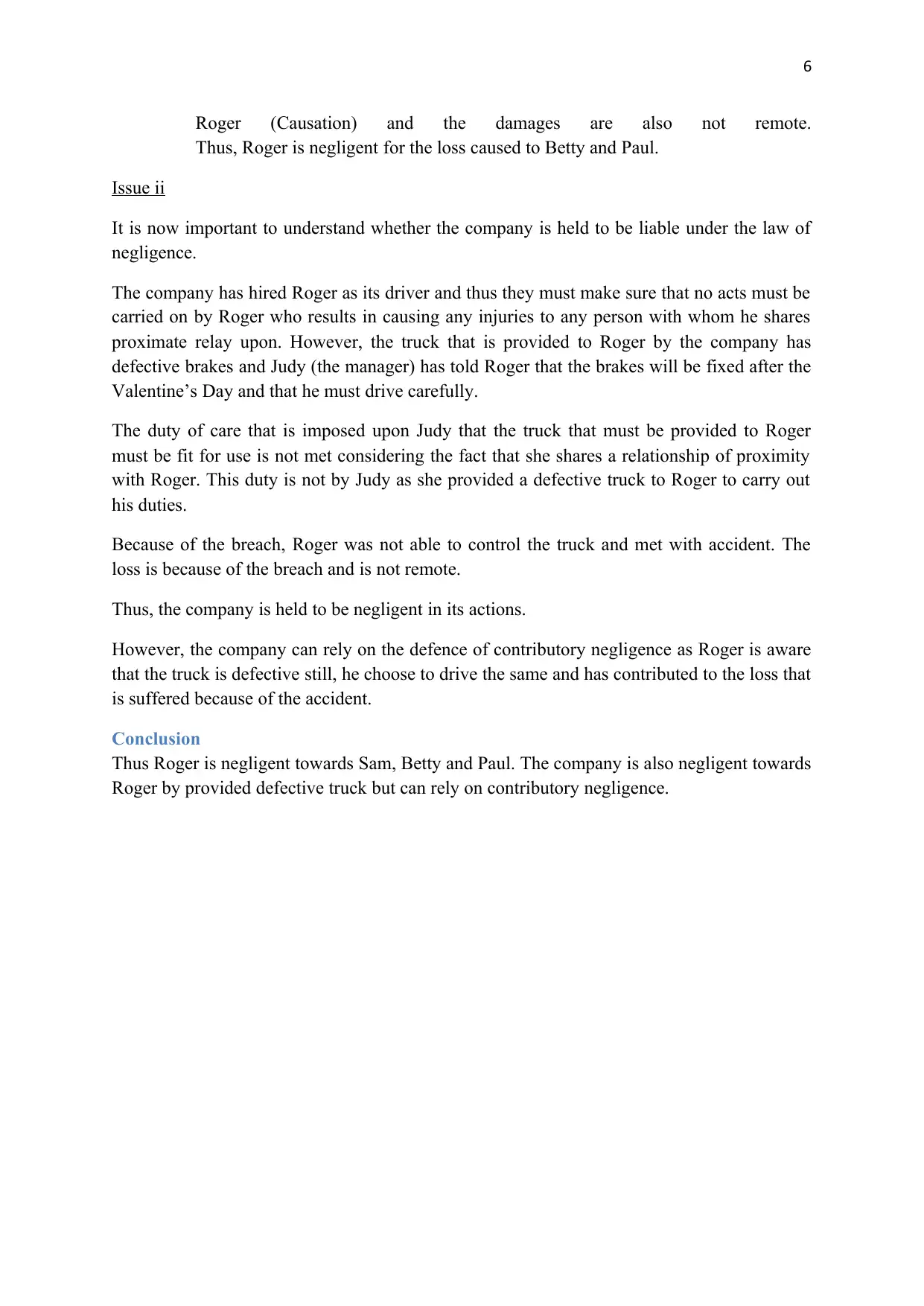
6
Roger (Causation) and the damages are also not remote.
Thus, Roger is negligent for the loss caused to Betty and Paul.
Issue ii
It is now important to understand whether the company is held to be liable under the law of
negligence.
The company has hired Roger as its driver and thus they must make sure that no acts must be
carried on by Roger who results in causing any injuries to any person with whom he shares
proximate relay upon. However, the truck that is provided to Roger by the company has
defective brakes and Judy (the manager) has told Roger that the brakes will be fixed after the
Valentine’s Day and that he must drive carefully.
The duty of care that is imposed upon Judy that the truck that must be provided to Roger
must be fit for use is not met considering the fact that she shares a relationship of proximity
with Roger. This duty is not by Judy as she provided a defective truck to Roger to carry out
his duties.
Because of the breach, Roger was not able to control the truck and met with accident. The
loss is because of the breach and is not remote.
Thus, the company is held to be negligent in its actions.
However, the company can rely on the defence of contributory negligence as Roger is aware
that the truck is defective still, he choose to drive the same and has contributed to the loss that
is suffered because of the accident.
Conclusion
Thus Roger is negligent towards Sam, Betty and Paul. The company is also negligent towards
Roger by provided defective truck but can rely on contributory negligence.
Roger (Causation) and the damages are also not remote.
Thus, Roger is negligent for the loss caused to Betty and Paul.
Issue ii
It is now important to understand whether the company is held to be liable under the law of
negligence.
The company has hired Roger as its driver and thus they must make sure that no acts must be
carried on by Roger who results in causing any injuries to any person with whom he shares
proximate relay upon. However, the truck that is provided to Roger by the company has
defective brakes and Judy (the manager) has told Roger that the brakes will be fixed after the
Valentine’s Day and that he must drive carefully.
The duty of care that is imposed upon Judy that the truck that must be provided to Roger
must be fit for use is not met considering the fact that she shares a relationship of proximity
with Roger. This duty is not by Judy as she provided a defective truck to Roger to carry out
his duties.
Because of the breach, Roger was not able to control the truck and met with accident. The
loss is because of the breach and is not remote.
Thus, the company is held to be negligent in its actions.
However, the company can rely on the defence of contributory negligence as Roger is aware
that the truck is defective still, he choose to drive the same and has contributed to the loss that
is suffered because of the accident.
Conclusion
Thus Roger is negligent towards Sam, Betty and Paul. The company is also negligent towards
Roger by provided defective truck but can rely on contributory negligence.
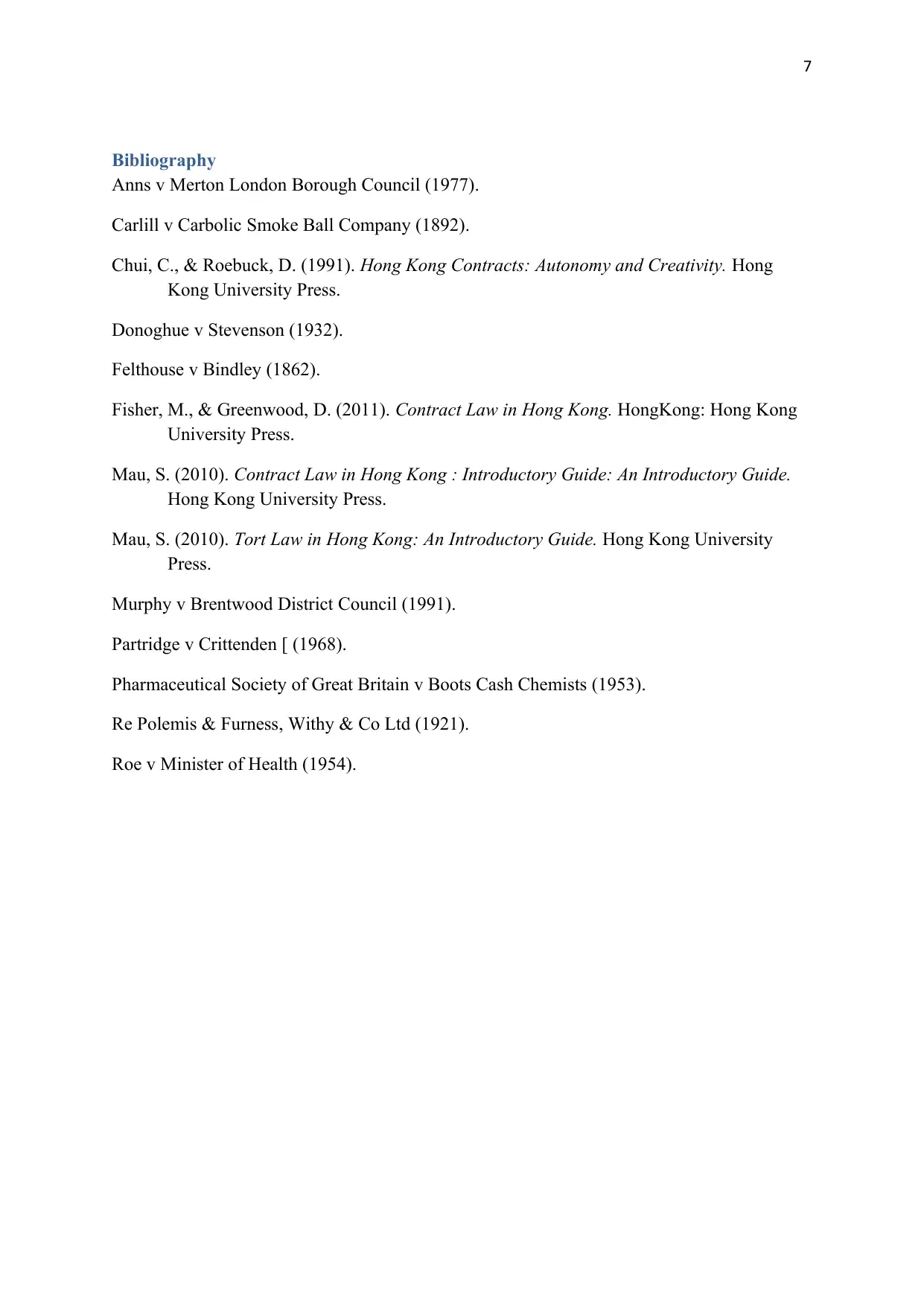
7
Bibliography
Anns v Merton London Borough Council (1977).
Carlill v Carbolic Smoke Ball Company (1892).
Chui, C., & Roebuck, D. (1991). Hong Kong Contracts: Autonomy and Creativity. Hong
Kong University Press.
Donoghue v Stevenson (1932).
Felthouse v Bindley (1862).
Fisher, M., & Greenwood, D. (2011). Contract Law in Hong Kong. HongKong: Hong Kong
University Press.
Mau, S. (2010). Contract Law in Hong Kong : Introductory Guide: An Introductory Guide.
Hong Kong University Press.
Mau, S. (2010). Tort Law in Hong Kong: An Introductory Guide. Hong Kong University
Press.
Murphy v Brentwood District Council (1991).
Partridge v Crittenden [ (1968).
Pharmaceutical Society of Great Britain v Boots Cash Chemists (1953).
Re Polemis & Furness, Withy & Co Ltd (1921).
Roe v Minister of Health (1954).
Bibliography
Anns v Merton London Borough Council (1977).
Carlill v Carbolic Smoke Ball Company (1892).
Chui, C., & Roebuck, D. (1991). Hong Kong Contracts: Autonomy and Creativity. Hong
Kong University Press.
Donoghue v Stevenson (1932).
Felthouse v Bindley (1862).
Fisher, M., & Greenwood, D. (2011). Contract Law in Hong Kong. HongKong: Hong Kong
University Press.
Mau, S. (2010). Contract Law in Hong Kong : Introductory Guide: An Introductory Guide.
Hong Kong University Press.
Mau, S. (2010). Tort Law in Hong Kong: An Introductory Guide. Hong Kong University
Press.
Murphy v Brentwood District Council (1991).
Partridge v Crittenden [ (1968).
Pharmaceutical Society of Great Britain v Boots Cash Chemists (1953).
Re Polemis & Furness, Withy & Co Ltd (1921).
Roe v Minister of Health (1954).
1 out of 7
Related Documents
Your All-in-One AI-Powered Toolkit for Academic Success.
+13062052269
info@desklib.com
Available 24*7 on WhatsApp / Email
![[object Object]](/_next/static/media/star-bottom.7253800d.svg)
Unlock your academic potential
© 2024 | Zucol Services PVT LTD | All rights reserved.





